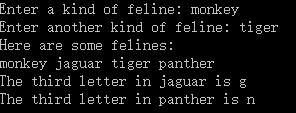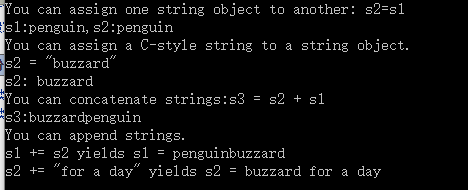C++学习(九)入门篇——String类
可以用string类而不是字符数组来存储字符串,string更加简单
要是用string类,则要在程序中包含头文件string,且位于std名称空间中,string类隐藏了字符串的数组性质,可以像处理普通变量那样处理字符串
程序清单4.7 strtype1.cpp //strtypel.cpp - - using the C++ string class #include<iostream> #include<string> int main() { using namespace std; char charr1[20]; char charr2[20] = "jaguar"; string str1; string str2 = "panther"; cout << "Enter a kind of feline: "; cin >> charr1; cout << "Enter another kind of feline: "; cin >> str1; cin.get(); cout << "Here are some felines:\n"; cout << charr1 << " " << charr2 << " " << str1 << " " << str2 << endl; cout << "The third letter in " << charr2 << " is " << charr2[2] << endl; cout << "The third letter in " << str2 << " is " << str2[2] << endl; cin.get(); }
输出结果:

string对象声明为简单变量
char数组为一组用于存储字符串的char存储单元,string类为一个存储字符串的实体
除了数组初始化可用列表初始化,也适用于字符串初始化
char first_date[ ] ={"Le Chapon Dodu"};
string second_date={"Le Chapon Dodu"};
char third_date[ ] {"Le Chapon Dodu"};
string forth_date {"Le Chapon Dodu"};
不能将一个数组赋给另一个数组,但可以将一个string对象赋给另一个string对象
char charr1[20]; char charr2[20] = "jaguar"; string str1; string str2 = "panther"; charr1=charr2; //不允许这么做 str1=str2; //可以
string类简化了字符串合并操作
还可以将两个string对象合并起来
string str3; str3 = str1+str2; str1+=str2;
程序清单4.8 strtype2.cpp //strtype2.cpp - - assigning,adding,and appending #include<iostream> #include<string> int main() { using namespace std; string s1 = "penguin"; string s2, s3; cout << "You can assign one string object to another: s2=s1\n"; s2 = s1; cout << "s1:" << s1 << ",s2:" << s2 << endl; cout << "You can assign a C-style string to a string object.\n"; cout << "s2 = \"buzzard\"\n"; s2 = "buzzard"; cout << "s2: " << s2 << endl; cout << "You can concatenate strings:s3 = s2 + s1\n"; s3 = s2 + s1; cout << "s3:" << s3 << endl; cout << "You can append strings.\n"; s1 += s2; cout << "s1 += s2 yields s1 = " << s1 << endl; s2 += " for a day"; cout << "s2 += \"for a day\" yields s2 = " << s2 << endl; cin.get(); }
结果:

在C++新增string类前,还是要完成给字符串赋值,用头文件cstring中的函数来完成,用函数strcpy()将字符串复制到字符数组中,用strcat()将字符串附加到字符数组末尾
strcpy(charr1,charr2); //copy charr2 to charr1 strcat(charr1,charr2); //append contents of charr2 to charr1
程序清单4.9 strtype3.cpp //strtype3.cpp - - more string class features #include<iostream> #include<string> #include<cstring> int main() { using namespace std; char charr1[20]; char charr2[20] = "jaguar"; string str1; string str2 = "panther"; str1 = str2; strcpy_s(charr1,charr2); str1 += " paste"; strcat_s(charr1, " juice"); int len1 = str1.size(); int len2 = strlen(charr1); cout << "The string " << str1 << " contains " << len1 << " characters.\n"; cout << "The string " << charr1 << " contains " << len2 << " characters.\n"; cin.get(); }
输出:

函数strlen()是一个常规函数,返回该字符串包含的字符数。
str1是一个对象,而size()是一个类对象,所以这样调用str1.size()
string类I/O
//strtype4.cpp - - line input #include<iostream> #include<string> #include<cstring> int main() { using namespace std; char charr[20]; string str; cout << "Length of string in charr before input:" << strlen(charr) << endl; cout << "Length of string in str before input:" << str.size() << endl; cout << "Enter a line of text:\n"; cin.getline(charr, 20); cout << "You entered: " << charr << endl; cout << "Enter another line of text:\n"; getline(cin, str); cout << "You entered:" << str << endl; cout << "Length of string in charr after input:" << strlen(charr) << endl; cout << "Length of string in str after input:" << str.size() << endl; cin.get(); }
输出:

数组charr字符串长度为31
说明未被初始化的数据,第一个空字符出现的位置是随机的,在数组末尾几个字节后才遇到空字符
getline(cin,str);
将cin作为参数,指明去哪里查找输入,也没有指出字符串的长度,因为string对象根据字符串的长度自动调整自己的大小
getline()是istream的类方法,但在引入string类很久以前,C++就有istream类,所以没有处理string对象的类方法
其他形式的字符串字面值
wchar_t title[ ] =L"Chief Astrogator"; char16_t name[ ] =u"Felonia Ripova"; char32_t car[ ] =U"Humber Super Snipe";
C++分别使用前缀L、u、U来表示
还有可以使用原始字符串类型,在原始字符串中,字符表示的就是自己
cout<<R"(Jim "King" Tutt uses "\n" instead of endl.)"<<'\n';
在这里\n不代表换行符,而是常规字符斜杠和n
“( )”作为定界符,用前缀R来标识原始字符串
输入原始字符串时,按回车键不会移到下一行,而会在原始字符串中添加回车字符
如果要在原始字符串中包含)”,因为编译器见到第一个)”会到此结束,所以要重新定义边界符号
可以在开头“和(之间添加任意其他字符(不包括左括号、右括号、空格、斜杠和控制字符),那么结尾)‘’中间也要添加一样的其他字符
cout<<R"+*("(Who wouldn't?)",she whispered.)+*"<<endl;
可将R和其他字符串前缀结合,如Ru或者UR,来标识wchar_t等字符串



 浙公网安备 33010602011771号
浙公网安备 33010602011771号